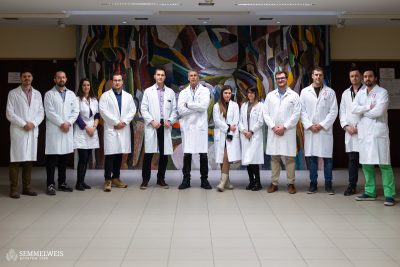An electronically available multimorbidity map has been made with the participation of Semmelweis University’s researchers. The map shows the comorbidity of various diseases and the links between the 250 most important illnesses. The open database, which was made with the use of innovative methods of biostatistics, provides hundreds of thousands of data. It allows a quick research of links between different diseases, such as the most frequently occurring cardiovascular diseases in case of diabetes, or the separate comorbidity map of depression.
 “The links between 250 important diseases are available in the recently published comorbidity map, which is accessible only in English. The diseases range from psychiatric, neurological and endocrine diseases through cardiovascular and locomotor diseases to the dysfunction of blood forming organs.”, Dr. György Bagdy, Vice-Rector for Scientific Affairs said, who is one of the authors of the paper.
“The links between 250 important diseases are available in the recently published comorbidity map, which is accessible only in English. The diseases range from psychiatric, neurological and endocrine diseases through cardiovascular and locomotor diseases to the dysfunction of blood forming organs.”, Dr. György Bagdy, Vice-Rector for Scientific Affairs said, who is one of the authors of the paper.
The paper authored by researchers from Semmelweis University, Budapest University of Technology and Economics and the University of Manchester has recently been published in the journal PLOS Computational Biology. The basis for the research was provided by a biobank in the United Kingdom, from which the data of 117,000 participants were analysed. There is free access to the publication (bioinformatics.mit.bme.hu/UKBNetworks) which makes it possible for everybody to carry out interactive searches in the comorbidity map.
 “Browsing the map could be interesting for medical researchers, physicians or even laymen, because the comorbidity of diseases is a common and well-known phenomenon.”, Dr. György Bagdy said.
“Browsing the map could be interesting for medical researchers, physicians or even laymen, because the comorbidity of diseases is a common and well-known phenomenon.”, Dr. György Bagdy said.
Depending on the different variables that can be entered (disease pairs, groups), the system may provide hundreds of thousands of results. The map can answer such questions as whether there are direct links between a patient’s multiple diseases (eg. a shared and damaged biochemical pathway or a mutually shared genetic problem) or their coexistence is merely accidental. The link between diseases is visually displayed by a line, whose thickness indicates the strength of the connection.
Dr. Andrea Juhász, associate professor of the Department of Pharmacodynamics and author of the publication illustrated the mechanism of the programme with the example of diabetes.
 “In case of type 2 diabetes we are able to search for those cardiovascular diseases that are closely related to it with the help of statistical data. Based on the results, high blood pressure and angina (chest pain) are closely related to diabetes, whereas stroke is a threat to patients with diabetes because of the potential development of hypertonia or cardiac arrest.”, she said.
“In case of type 2 diabetes we are able to search for those cardiovascular diseases that are closely related to it with the help of statistical data. Based on the results, high blood pressure and angina (chest pain) are closely related to diabetes, whereas stroke is a threat to patients with diabetes because of the potential development of hypertonia or cardiac arrest.”, she said.
Several networks of diseases have been drawn up by the researchers, including the multimorbidity map of depression. This clearly shows that depression is strongly connected to the other psychiatric diseases, but it is also related to obesity and other physical deformities and diseases. A direct link between migraine and depression has also been found, even though not in the case of all patients. However, the previously assumed link between diabetes and depression turned out to be indirect, and is caused by obesity in case of patients with depression.
“Understanding the comorbidity of diseases and knowing whether the various diseases of the patient are linked mean an important step towards making an accurate diagnosis, and choosing appropriate examinations and medication.”, Dr. Gabriella Juhász said.
The realisation of the map was done by the research group lead by Dr. Péter Antal, associate professor at the Budapest University of Technology and Economics with the use of innovative methods of biostatistics.
Pálma Dobozi
Photo: Attila Kovács, Semmelweis University
Translation: Ágnes Raubinek


